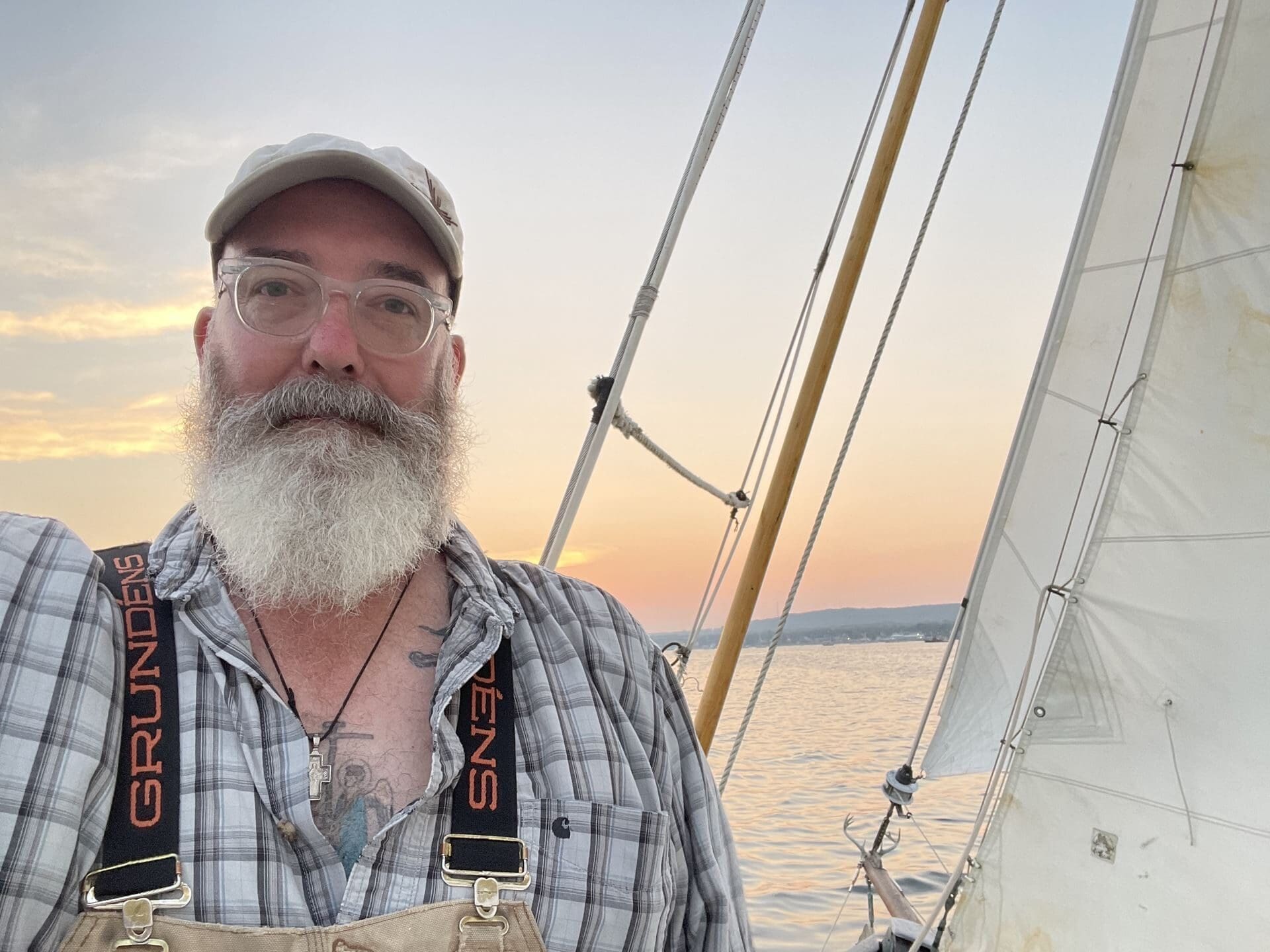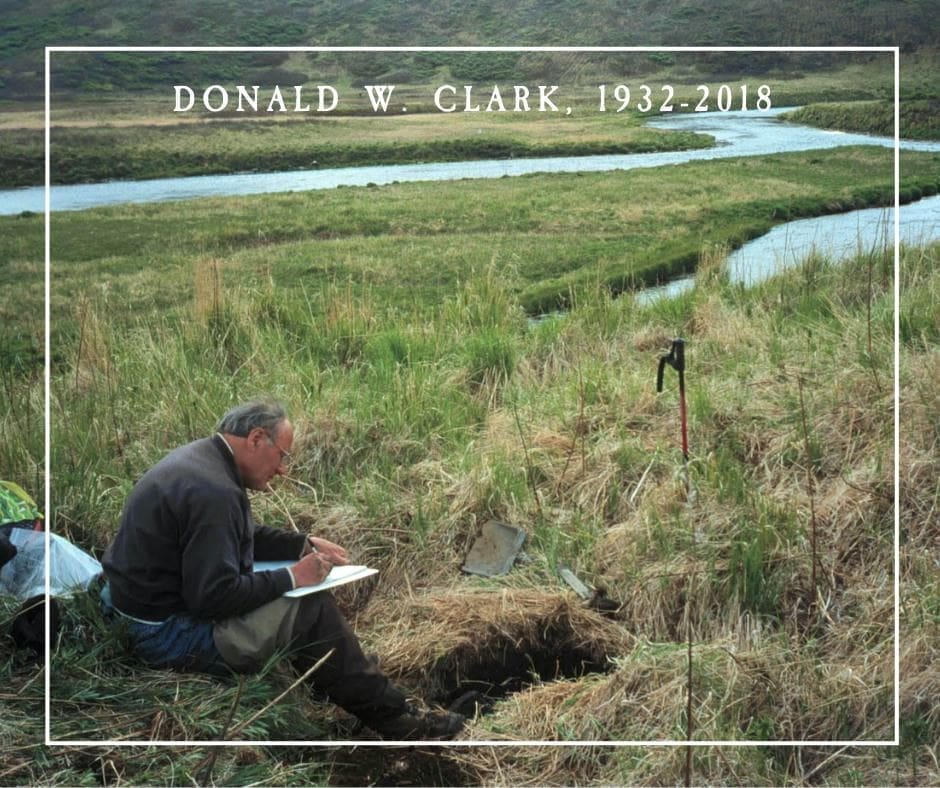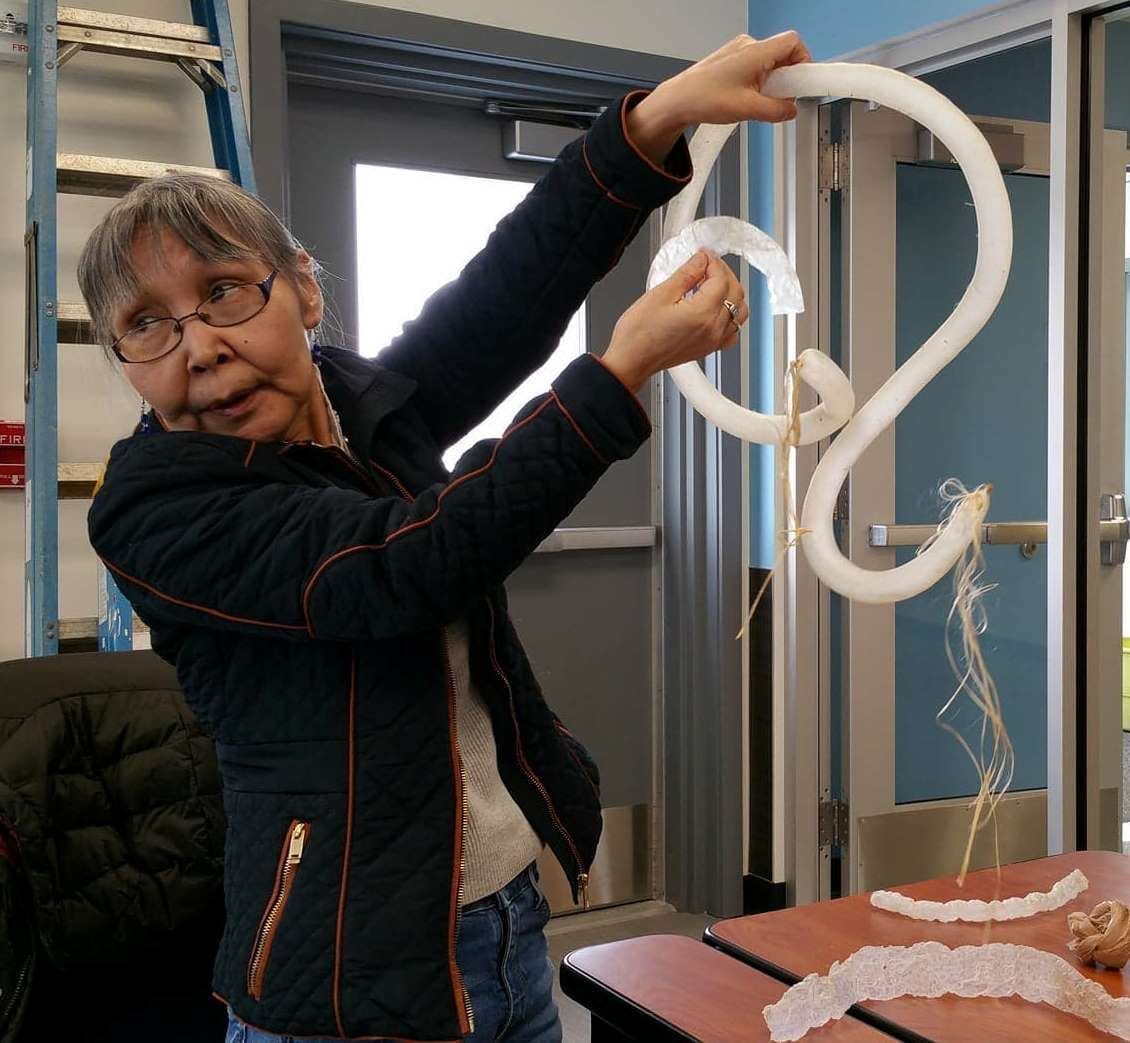Every year at our annual conference, we recognize individuals who have gone above and beyond in their dedication to museums. This year we are honoring four amazing individuals who have dedicated time, money, and their passion for teaching to improve museums across Alaska.
Award for Excellence in the Museum Field
AWARDEE: DAWN BIDDISON

Dawn Biddison filming the Material Traditions Moosehide project. Photograph by Scott Moon, Kenaitze Tribe. You can find video sets from the Material Traditions programs in the “Community Videos” section at this link: https://learninglab.si.edu/org/sasc-ak
Dawn Biddison is a Museum Specialist at the Smithsonian Arctic Studies Center based at the Anchorage Museum who does exceptional work—particularly on the Material Traditions program.
She received her undergraduate degree from Columbia University and University College London where she pursued a cross-cultural emphasis to her study of psychology. In 2002 she completed her Masters in Anthropology at the University of Alaska Fairbanks.
Since 2012, the Smithsonian Arctic Studies Center and Anchorage Museum have hosted artists residencies and community workshops, titled Material Traditions. During the program accomplished Alaska Native artists are invited to demonstrate their work in important cultural forms and materials. These often combine traditional with innovative and experimental techniques that are shared with museum visitors and participants in the programs. Material Traditions programs have focused on fish skin, porcupine quill, gut skin, walrus ivory, cedar wood, cedar bark, moose hide and grass. Most of these materials are either difficult to source, process, or the knowledge is struggling to survive. The programs are unique in that film documentaries of the material processing and use are created, the artists selected are teachers in their own communities, and an environment is provided that enables artists and museum conservators to share their expertise. There have been immense benefits for the artists, communities, museum professionals and the museum objects for which we care.
Dawn Biddison develops the Material Traditions programs and has been instrumental in its continuing success. She works extensively with the artists and community to organize, conduct and video-document the material gathering and processing events. Dawn often edits the video footage for online and DVD release and works with Alaska Native educators to develop learning resources for classrooms, culture camps and home.
Tremendous effort and organization goes into planning and implementing an artist residency program like Material Traditions. Dawn Biddison as her role as project manager is essential, to ensure that there are enough of the practical items: raw materials, supplies, chairs, tables and good lighting, but to also consider breaks, snacks and lunches for the artists. Dawn works tirelessly in the background to create an environment that allows all participants to fully engage.
Her high level of project management helps accommodate real time changes in the schedule, such as weather delays and requested changes to planned processing activities by artists. The program can be challenging to plan, since so much of information comes spontaneously as the artists are working on their projects. Dawn’s approach to project management ensures a balance between providing space for this to happen, while still providing sufficient structure to move the program along and make it meaningful.
She is flexible to respond quickly to feedback and to change presentation formats during the program which has been greatly appreciated by artists, and has been essential to the success of the program series. While the teaching aspect of the program is important, artists also need space and time for the new working environment. Working in museums can be both physically and emotionally draining. Dawn’s awareness and empathy of this helps participants and the program as a whole.
Often this is the first time artists have agreed to document a process from start to finish. Having participated in these programs as a conservator it is clear that a main reason they have been such a success is because artists trust Dawn to respect the elders and Indigenous knowledge. Dawn understands all the complex logistical and human factors involved in the programs. She is flexible, resourceful, adapts to the needs of the artists and other participants, and respects cultural values and cultural norms of the people she is working with. She gives careful consideration to the variable factors such as personalities, expectations, cultural sensitivity, gifts, breaks, supplies, work methods, styles, information gathering, appropriate filming, and post-program data management. Her contact amongst program participants has extended beyond the programs, creating strong and enduring relationships that help break down the past barriers often created by museums.
Volunteer of the Year Award
AWARDEE: PAUL GILL

Paul Gill. Photograph courtesy of Paul Gill.
It is rare to find someone who understands the importance of the daily maintenance associated with caring for a National Historic Landmark. From putting up storm windows, to moving furniture and taking out recycling, Paul has been there for our team.
Paul has contributed over 40 hours of volunteering with us in the past year. He is our right-hand handyman, always by our side when heavy lifting is needed. During the COVID-19 pandemic he continued to help us maintain the building and even donated over 20 hours of his time helping with our collections object inventory.
Most notably, Paul advocates for the importance of small local history museums like ours in our community and everywhere he travels. He and his wife, Susan, are avid travelers and where ever they go, Paul brings his KHM volunteer badge and talks about his local museum. He then brings knowledge back from his travels and shares it with us here in Kodiak. He brings a sense of community to our work.
Museum Champion
AWARDEE: DR. DONALD W. CLARK

Dr. Donald W. Clark. Photograph courtesy of the Alutiiq Museum.
The Alutiiq Museum and the Kodiak History Museum, nominated the late Dr. Donald W. Clark (1932-2018) for the Museums Alaska Museum Champion Award. Raised in Kodiak, Clark was a leader in studying the archipelago’s history. He was locally known as the “father of Kodiak archaeology”. He was the first researcher to describe the sequence of local cultures, tracking the development of Alutiiq societies over 7,000 years. His detailed studies of everything from slate working, to fur seal hunting, petroglyphs, the ground squirrels of Chirikof Island, and nineteenth century Alutiiq villages remain a foundation for research. He was an exacting, prolific scholar but also kind and generous. He loved working with students and believed firmly in the power of community museums to share history with the public.
As a young man, Clark helped to found and run the Kodiak Historical Society and served as its president. A number of the Kodiak’s History Museum’s collections are donations from his research. In his later years, Clark worked closely with the Alutiiq Museum, participating in archaeological field research, providing meticulous evaluations of publications, mentoring students at all levels, and donating his personal papers and library to the organization.
In a final act of generosity, Clark left a total of $2.45 million dollars to our two museums. Our institutions, which lie just two blocks apart, were both recipients of game-changing donations from his estate. The funds represent a substantial portion of Clark’s life savings and a major investment in sharing Kodiak’s history with future generations. Clark’s support provides an important measure of financial stability for the organizations positioned to carry out the work he began. Neither institution knew he had made this commitment until after his death. He never mentioned it.
For his life-long dedication to heritage preservation and his quiet but enormous support of our institutions, we nominate Clark for the Museum Champion award. His generosity and thoughtful planning will have a lasting impact on Kodiak and the museum’s that share its stories. Both our organizations invested the bequests in funds that will provide operational support for generations.
At the Alutiiq Museum, earnings from Clark’s gift will underwrite facilities costs and at the Kodiak History Museum they are helping to expand essential staffing. We believe that Clark’s generosity and its far reaching impacts deserve this recognition.
President’s Award in Honor of Lifetime Achievement
AWARDEE: ELAINE KINGEEKUK

Elaine Kingeekuk teaching a gutskin workshop at UAF Northwest Campus. Photograph by Jackie Hrabok.
Elaine Kingeekuk (St. Lawrence Island Yupik) has been sharing her knowledge about skin sewing with students, artists, and museums for over 30 years. Ms. Kingeekuk was born and raised in Savoonga and comes from a long line of St. Lawrence Island Yupik artists. She is a doll maker, basket maker, and skin sewer who works with materials such as seal and walrus gut, seal skin, and polar bear skin. Ms. Kingeekuk learned the art of processing and sewing gut from her mother Ruthelle Kingeekuk. In Savoonga, Ms. Kingeekuk taught cultural and language studies at Hogarth Kingeekuk Sr. Memorial School for 23 years.
Ms. Kingeekuk has served as a valuable guide and contributor to numerous museum projects over the years. She served as an advisor for the Smithsonian exhibition Living Our Cultures, Sharing our Heritage: The First Peoples of Alaska that opened in 2010 and helped to mend the ceremonial gut parka that is now on display at the Anchorage Museum. In 2012, she participated in a St. Lawrence Island Yupik language and culture seminar hosted by the Alaska Office of the Smithsonian’s Arctic Studies Center. As part of the seminar, she assisted in documentation of the St. Lawrence Island Yupik language and helped to create teaching materials for use in schools and homes that can now be freely accessed via the Smithsonian Learning Lab. A collaborative book between Ms. Kingeekuk and Herminia Din, Professor of Art, University of Alaska Anchorage, was published in 2012 titled, Seal, Thimble & Sinew Thread – Sewing Art of the Siberian Yupiks from Savoonga, Alaska. The publication includes images of gutskin artwork, skin sewing techniques, and personal histories behind the art pieces.
During 2014, Ms. Kingeekuk joined artists Mary Tunuchuk (Yupik) and Sonya Kelliher-Combs (Inupiaq/Athabascan) in the Material Traditions: Sewing Gut artist residency at the Anchorage Museum. Ms. Kingeekuk and the other artists shared their knowledge about processing and sewing sea mammal gut with University of Alaska Anchorage Native art students, Anchorage school district students, and museum visitors. Interviews and film footage taken during the residency were used to create a DVD shared with communities and museums across Alaska and are accessible on the Smithsonian Arctic Studies Center YouTube channel.
Ms. Kingeekuk partnered with Museums Alaska for the 2015 Angels Project and led conservation of a bear gutskin parka in the collection of the Cordova Historical Museum. In 2018, she led a gutskin workshop for a group of enthusiastic students from the Bering Strait region at the University of Alaska Fairbanks Northwest Campus in Nome. The following year, she taught students at Mt. Edgecumbe High School in Sitka how to make St. Lawrence Island Yupik gutskin baskets during Founder’s Week. In 2020-2021, Ms. Kingeekuk partnered with the Carrie M. McLain Memorial Museum to create a gutskin mask and bib decorated with traditional materials and embedded with cultural knowledge that she shared through a series of oral history interviews.
Through her commitment to passing on St. Lawrence Island Yupik culture and heritage, Elaine Kingeekuk has left an incredible legacy of historic preservation along with the knowledge and skills needed to transform marine mammals into clothing and art which might otherwise have been lost. Ms. Kingeekuk’s generous and kind spirit has touched many over the years and her career presents a shining example of collaborative museum work to which we can all aspire.
Congratulations to all of the awardees! And thank you for everything you’ve done for museums across Alaska!